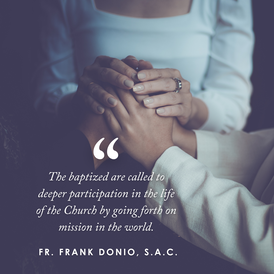 As the Church arrives at the first session of the Synod on Synodality, it is important to look at the three words associated with it – communion, participation, and mission. These are at the center of the dialogue and discernment that will occur. They are part of an ongoing reflection on the role of the baptized in the life of the Church, particularly from the Second Vatican Council onward. We are in communion with the Most Holy Trinity and each other in the Body of Christ, the Church. The baptized are called to deeper participation in the life of the Church by going forth on mission in the world. Each is co-responsible for the mission of Christ and the Church. As Pope Francis notes, “The Synod has three key words: communion, participation, and mission. Communion and mission are theological terms describing the mystery of the Church… Participation is a requirement of the faith received in baptism” (Address for the Opening of the Synod). The whole synodal process is a discernment in the Holy Spirit to examine how we as Church are on mission in the world. Have we closed ourselves off by becoming self-referential or are we moving outward as witnesses of Christ? Pope Francis is clear about what this discernment of the Synod is and is not. “I want to say again that the Synod is not a parliament or an opinion poll; the Synod is an ecclesial event and its protagonist is the Holy Spirit. If the Spirit is not present, there will be no Synod” (Address for the Opening of the Synod). We at Catholic Apostolate Center offer many resources to learn more about the upcoming first session of the Synod of Synodality, which will begin on October 4th and continue throughout the month, including a recent episode of our podcast, On Mission, with Dr. Susan Timoney, Associate Dean for Graduate Ministerial Studies in the School of Theology and Religious Studies at The Catholic University of America. Dr. Timoney gives an overview of the synodal process thus far and what is to come. It is worth taking the time to listen! Please keep all those involved in the Synod in your prayers. May the Charity of Christ urge us on! In God, the Infinite Love, Fr. Frank
0 Comments
This past week, I had the opportunity to be an extra in The Chosen TV series. The show is currently filming the 4th of 7 seasons and is based on the lives of those who were “chosen” to follow Jesus. Some statistics state that “Season 1 was the largest crowd-funded project of all time raising $10 million from over 19,000 people. After 3 seasons, there have been 110 million unique viewers watching the episodes 520 million times across 175 countries. The whole series will soon be dubbed in 50 languages with plans to subtitle in over 600!”
One word that describes this show and the phenomenon that it’s generated is communion. During this Eucharistic Revival, it’s critical to draw our attention to the one-ness that Jesus desires for His Church: “I pray not only for them, but also for those who will believe in me through their word, so that they may all be one, as you, Father, are in me and I in you, that they also may be in us, that the world may believe that you sent me.” John 17:20-21 Eucharist means “thanksgiving” while Communion means “sharing in common.” Communion is the way we come together to share what we have received from God. A popular motto concerning the show is “it’s not our job to feed the 5,000, it’s only to provide the loaves and fish.” God gives each of us a gift and calls us to the table to share it with others so all can be fed. The world is being fed by diving deeper into the greatest story ever told – Jesus Christ, born in Bethlehem, raised by two devout Jewish parents, and gathering a unique group of friends one-by-one (if you’ve read the Bible, you know the spoilers that He is crucified, laid in a tomb, and then is seen speaking and eating with his friends once again, but that’s not until Seasons 6 and 7). Creating a show requires an astounding number of people to come together to make the final product. Though the focus is on the main cast on screen, it’s important to have background actors bringing the scene to life, set designers making it look realistic, makeup artists transforming characters, crew supporting the cast in between takes, assistant directors helping the director, writers, producers, editors, etc. We are all needed to tell a good story. For example, though a priest is able to say Mass on his own, the celebration of the Liturgy includes the congregation and the various ministers that assist him. God made us for community and that’s a big reason why we are obligated to participate in Mass weekly. Uniting together in prayer, song, and fellowship encourages and enlivens us as we continue to bring life to faith and faith to life as we carry our individual crosses each day. As a TV show, The Chosen has attracted viewers of all backgrounds, cultures, and beliefs. The focus on the historical Jesus unites people because we can all share the experience of being human. In between takes on the hot Utah set, I sat in the air-conditioned tent with hundreds of background volunteers from around the world. Some lived down the street and others flew across oceans to come together for this experience. I met people from all denominations and know that not all were even believers. They were just intrigued by the community that has formed around the show. During the last day of filming last week, the cast was required to strike in union with the Screen Actors Guild. Since the show itself is independent from Hollywood, production could continue with the background actors. It was strange to be on set without Jesus and the disciples, but it reminded me of the quote from St. Teresa of Avila: “Christ has no body now but ours, no feet but ours.” My fellow background actors embraced this opportunity to carry the load on set for the cast who were missing us since they stayed home. While “TV actor Jesus” (Jonathan Roumie) was not visible, I believed that Jesus Christ was indeed present. At Mass, we may not see the historical Jesus with our eyes or hear him with our ears. And yet, the priest stands in persona Christi so Christ’s Word can be heard and His Body and Blood received. I’m often asked if I’m Catholic or Christian. Catholicism means “universal.” No matter where I go in the world, I can find a Catholic Mass and feel like I’m at home. Though the prayers may be in a different language than my native tongue, the same Jesus is present in the Eucharist. My experience as a background actor reminded me of how everyone is needed, but not everyone has to stand out. In relationships, it’s about “we” not about “me.” The directors told us that background actors support the scene, not distract from it. If we draw attention to ourselves, the focus on the whole scene can be thrown off so we may be edited out. In our lives, we may feel like “just background,” but in reality, those ordinary roles can create an extraordinary impact. . The background actors who were a part of those large-scale scenes aren’t able to pick themselves out on screen, but joyfully share how it felt to be a part of the crowd. The joy we experience in life comes from standing among our brothers and sisters, not from standing out. Questions for reflection: We are each chosen to live in communion with one another. How are you participating in the Body of Christ?
**The reason I chose this picture is because each one of those people represents a different country! They are all social media representatives for The Chosen!**
Many of my fondest memories were created at a family meal around a table. Relaxed Sunday dinners when no one had to rush off for work or commitments, picnics at the park in the great outdoors, holiday meals with all the finery, birthday celebrations, and nightly dinners where we all paused amidst our busy schedules were the catalyst to so many good and wonderful things in my life. Whatever the occasion, the common thread was that our family intentionally gathered together, prayed, ate, and shared precious time with each other. It taught me the importance of being a family unit (both immediate and extended), and it revealed to me the richness of each person’s part in the building of a family as God intended it. The way we are linked together with our combined unique talents and personalities creates a beautiful and diverse whole unit. The stories shared, the laughter, the lessons learned are where I came to understand the “heart” of family. The communion of our rich and diverse individual lives seated at table together strengthens and nourishes us much more than the food we partake of. Our bodies and our spirits are nourished at these meals.
It is by no accident or random act that Jesus gathered His family and apostles around the table together. It was a calling together in a very basic physical manner—to nurture the body and the soul of each person there. The Communion Jesus instituted is the very essence by which He feeds us with what we need to carry out our mission as Christians, to share the Gospel message in our words and deeds. His Body, Blood, Soul, and Divinity is the complete sacrifice given to us each and every time we approach His table at Mass. The more we gather there, the more we are nourished with grace and wisdom, strength and virtue to equip us to enter the daily fray and to live the Christian life—to be bearers of God’s truth and love. Following His example, a family learns and grows from intentionally sharing meals at table together. All that is involved in this gathering teaches and molds us. The food preparation, the setting of the table, giving thanks in prayer, sharing the food, the conversation exchanged, and the cleaning up are simple acts in themselves, but done together creates a unity and rhythm that cultivates the value of each person in the unit. As a child, I was privileged to grow up in a home where family meals were an integral part of our daily routine. I was also raised to recognize the importance of attending Holy Mass together, and it was a special time of week for our family. The Rev. Fulton J. Sheen so eloquently said: “The greatest love story of all time is contained in a tiny white host.” This is how Jesus feeds us—yesterday, today, and tomorrow. He made the profoundly complete meal so simple for us. All we need to do is to gather at His table. With each year, I come to realize how paramount it is to gather at the altar, to be present at the table of our Lord, in communion with my brothers and sisters, and to receive the Eucharist together—our Bread of Life! Through this sharing with our Lord and Savior, our Creator and Redeemer, our love stories grow deep. From this fullness I am able to love and serve my husband and children more perfectly, treat my neighbor with care and compassion, forgive those who hurt me more easily, give more, and want less. All goodness and mercy, tenderness and courage come from the meal at the table of the Lord. It has become an essential part of each day for me, and the blessings abound from it. I am grateful for the freedom we have to be able to attend Mass daily and to receive the divine sustenance needed to live in this fractured world. Receiving Jesus—His Body, Blood, Soul, and Divinity—is the ultimate gift. It helps me to be a better person and the ripple effect going out to others is endless. God’s design is so perfect! I encourage each of you to reflect on your personal spiritual love story and invite you to join your community at the table of the Lord as often as possible to be strengthened in what is necessary to bring about goodness in our lives. This love of God can heal this broken and divided world, and it is accomplished by God dwelling in and working through us—one person loving another. And a great place to practice is around the family table! As Mother Teresa told us: “If you want to change the world, go home and love your family.” 10/24/2019 The Apostolate of Accompaniment: Creating an Environment of Accompaniment in Our ParishesRead NowWhen people speak about the work of evangelization or accompaniment, they often speak about going out to the margins, “to the highways and the hedgerows” (Luke 14:23,) to bring the “nones” and the unbaptized into the Church. This is, of course, an essential part of Jesus’ final commission to his apostles to baptize and make disciples of all nations (Matthew 28:16-20). But I have to wonder: what’s the state of spiritual health in our own parishes? Are the lay faithful aware that their sacramental experience is an encounter with Christ, and do they care about their brothers and sisters with whom they share Communion? Are the people in our pews accompanied by anyone in their journey of faith or are they trying to live their faith on their own? There are many definitions for spiritual accompaniment, but in the book I co-authored with Colleen Campbell as a resource for the Catholic Apostolate Center, we define spiritual accompaniment as “the apostolate of intentional relationship that is oriented toward a definitive direction of growth in holiness and transformation in the Person of Christ.” In general, accompaniment is “a broad term that refers to a relationship between two or more people who share mutuality and reciprocity in the spiritual life” (The Art of Accompaniment). I believe this “apostolate” of accompaniment is essential to a parish’s spiritual health for three main reasons: First, creating a culture of accompaniment in the parish enables the lay faithful to be who they are called to be by their baptism. In the Rite of Baptism, we receive the Holy Spirit and we are made members of Christ’s Body. As members of the same Body, we have a responsibility to bring the light and love of Christ to one another. As Paul writes in First Corinthians, the various parts of the body must have concern for one another because we need each other (1 Corinthians 12:21-26). When members of the lay faithful take an interest in one another’s faith journeys, encouraging one another on that journey, they are living their Christian vocation as the Church intends. When members of the lay faithful are not concerned for members of their parish community, they become spiritually stunted and begin to believe that faith does not require community in one Body. Second, accompaniment helps a parish to become the best ordinary place of encounter with Christ. The parish is the most likely place where an individual begins his faith journey. Churches that sit on familiar street corners appear as safe havens for those who seek the Lord or some other help. The parish must embrace a culture of accompaniment so that when individuals approach it seeking communion, they are met with a warm and welcoming response instead of sacramental hoops or parish boundary restrictions. Accompaniment challenges parish staff and parishioners to “[respect] the dignity of the human person, and [seek] to increase their freedom to respond to the all-encompassing love of God within their life” (The Art of Accompaniment). Finally, it’s important that we implement a culture of accompaniment in our parishes because one of the goals of accompaniment is liturgical worship, and this can only take place in the parish. Sacramental theology reminds us that the sacraments are how Jesus accompanies and remains with his Church in a physical way (CCC 1088). Accompaniment’s goal is “transformation in the Person of Christ,” and if the lay faithful are serious about accompanying one another, they will encourage one another to seek out liturgical life at the parish, because the sacraments sanctify us, build up the body of Christ, and give worship to the One who Accompanies. For more resources on Accompaniment, please click here. To purchase The Art of Accompaniment, please click here. “The love of God and our relationship with the living Christ do not hold us back from dreaming; they do not require us to narrow our horizons. On the contrary, that love elevates us, encourages us and inspires us to a better and more beautiful life” (Christus Vivit, 138).
Have you ever experienced the love of Christ in your life? The love of Christ is not something one and done. It is an ongoing experience. Christ is always pouring out his love to us. We are the ones who are challenged to see and believe. The love of Christ comes to us in a particular way through the Sacraments, especially the Eucharist—an intimate encounter with Christ who is truly present. Pope Francis describes this encounter: “Although we are the ones who stand in procession to receive Communion; we approach the altar in a procession to receive communion, in reality it is Christ who comes towards us to assimilate us in him. There is an encounter with Jesus! To nourish oneself of the Eucharist means to allow oneself to be changed by what we receive” (General Audience, March 21, 2018). Christ is the one who is present and he is the one who is changing us in and through our encounter with him in the Eucharist. We can choose not to see his presence, not to enter this experience of encounter, and not to be changed. That is the freedom that we have. It is the freedom to be indifferent to or reject the love of Christ being freely offered to us. When we experience Christ in the Eucharist, the great gift of his love for us, we become more than we are. We are elevated to a greater love of God and neighbor. How do we enter more fully into this encounter with Christ in the Eucharist? As Pope Francis notes, Christ “comes towards us to assimilate us in him.” He is already moving, acting, and assisting us to cooperate with his grace. We are called to prepare ourselves well for this encounter by being forgiven of our sins through the Sacrament of Penance, by preparing for our encounter through prayer, by entering into the worship of the community of faith, and by witnessing the love of Christ in our daily encounters with others. Over time, we will be transformed by Christ toward living a “better and more beautiful life.” May the Charity of Christ urge us on! From the evening Mass of the Lord’s Supper until Evening Prayer on Easter Sunday, the Church celebrates a very special period called the Paschal Triduum. As the USCCB explains, the Easter Triduum is the summit of the Liturgical Year which “marks the end of the Lenten season.” Because of this important spiritual shift, there are some symbols used during this liturgical season that are unique to the Paschal Triduum, and I hope that you might find and reflect on these symbols this year as we commemorate the life, death, and Resurrection of Christ.
Holy Thursday Holy Oils The Holy Oils that are used by the Church throughout the year (Oil of the Sick, Oil of the Catechumens, and Holy chrism) may be presented during the entrance procession of the Mass of the Lord’s Supper on Holy Thursday. These oils are blessed by the Bishop during the Chrism Mass—which can happen on Holy Thursday or another time during Holy Week—with the priests of the diocese gathered at the local cathedral. During this celebration, all of the priests present renew their priestly vows. Ringing of the Bells During the “Gloria” which is sung on Holy Thursday, we hear the altar bells ringing! We are celebrating the Mass for the last time until the Easter Vigil, and the Church is in mourning so the bells will remain silent until we sing the “Gloria” again. Washing of the Feet As Jesus did at the Last Supper (John 14:1-17), the Church is called to wash the feet of the members of the Body of Christ during the celebration of the Institution of the Eucharist. This symbol of humility is a wonderful connection with the service of Christ. Ubi Caritas It is rare that the Church prescribes a specific hymn to be sung other than those prescribed for the Proper of the Mass, yet on Holy Thursday the Roman Missal says that we should sing the ancient song “Ubi Caritas” during the Offertory. A very simple song, the lyrics are very meaningful, especially for the Mass of the Lord’s Supper. Translated, they mean "Where charity is, God is there." Eucharistic Procession and Reposition The Church’s tabernacle, while normally filled with the Blessed Sacrament and reserved hosts, is emptied and brought to the Altar of Repose where the faithful are invited to join in Adoration. This procession is meant to be of great importance for the community and reminds us of the walk that Christ is about to take the following day on the Via Dolorosa, but instead of being nailed to a cross, we place our King in a place of honor. Good Friday Fonts After the Mass of the Lord’s Supper on Holy Thursday, churches are supposed to empty their Holy Water fonts “in preparation of the blessing of the water at the Easter Vigil, and it corresponds to those days on which the Eucharist is not celebrated (i.e., Good Friday and Holy Saturday).” (EWTN) Prostration On Good Friday, the Church is mourning the death of Christ and is full of sorrow. In response to this sorrow, the priest (and deacon, if present) prostates himself in front of a stark, barren altar. There is no music and none of the regular pomp and circumstance that comes with the beginning of a liturgical celebration. No sacraments are to be celebrated but that of penance and the anointing of the sick. The earth has gone quiet. No Invitation Normally, when a priest begins Mass, he invites us all to pray along with him, saying, “Let us pray.” During the Celebration of the Lord’s Passion (Good Friday), no such invitation is made. The priest just begins his invocation. Solemn Intercessions You may find that the prayers of the faithful may take longer than normal. Your church may sing them or have them chanted, with some kneeling and standing interspersed. Adoration of the Holy Cross There are many ways in which the Celebration of the Lord’s Passion is different from other liturgical celebrations, and the adoration of the Cross is certainly one of them. We are invited to come forward and spend time in veneration and adoration of the Cross on this most solemn of days – the day on which Christ perished while hanging from the very cross which we venerate. You may notice people genuflecting to the cross – this is something reserved specifically for Good Friday, out of veneration and sorrow for the blood which was shed and soaked up by the wood of the cross. Communion The Celebration of the Lord’s Supper is not a Mass. It is the one day out of the year in which no Mass is celebrated anywhere on Earth. Therefore, when we come to the celebration, there is no Eucharistic Prayer or any prayer related until, after the Adoration of the Holy Cross, the priest or deacon brings out the Blessed Sacrament and begins praying the Agnus Dei as it is normally done at Mass, which follows with himself and others receiving the Blessed Sacrament. Holy Saturday and the Easter Vigil Decoration When one walks into the church for the Easter Vigil, they will notice a big change from the celebrations of Lent and Holy Week – the church should be decorated with lilies, white and gold, and a joyful décor! While the lights should be turned down as well, we are anticipating the Resurrection and the excitement is palpable! The Light of Christ From the fire used to light the Easter Candle, the inscriptions on the Easter Candle, and the procession into the Church, light is integral to the Easter Vigil due to its representation of the "light of Christ, rising in glory," scattering the "darkness of our hearts and minds." We process into the Church with the Easter Candle, “just as the children of Israel were guided at night by the pillar of fire, so Christians follow the risen Christ” as we proclaim The Light of Christ while singing praises of thanksgiving! (USCCB) Readings Instead of the standard 3 readings at a Sunday Mass, at the Easter Vigil we generally hear anywhere between 5 and 9 readings. As we prepare to celebrate some of the holiest days in our Church, I invite you to observe the different rituals, customs, and symbols present during the Triduum. May you have a blessed and joyous Easter season! Question for Reflection: What changes do you notice from the Lent to Easter season? For more resources to guide you throughout the Triduum into the Easter season, please click here. While I was speaking with a priest not very long ago about young adult ministry and how to grow a community of young adults in my area, he said something which felt as if someone was smacking me on the head. Almost in passing, he remarked, “We must share the teachings of Jesus in such a way that people become disciples of Christ and not consumers of Christ.” I am sure this was not the most significant thing that he was getting at, and it was not the focus of our conversation. However, as I was driving home from that meeting, I could think of little else. As I reflected on this, I was reminded of a fundamental aspect of our faith. We are called to be in relationship. In a way, all the stories throughout the Bible, from Moses in the Old Testament to the teachings of Jesus in the Gospels, are about forming and maintaining relationships. Relationship is everything—relationship with God, our fellow brothers and sisters, and (as Pope Francis explained more recently in Laudato Si’) creation. Someone who is in a true relationship with God, humanity, and the environment will be seen as a disciple of Christ and not a consumer of Christ. But how do we do this? How do we realize the value in relationships? First, we must drop the idea that we deserve our relationship with Christ. Too often we seem to walk into the church on Saturdays to take the sacrament of reconciliation, or on Sundays to take the sacrament of Holy Communion just as if we were walking into a Starbucks and placing an order. But the sacraments are not about taking, they are about receiving. I think a “graduation mentality” can enter into our faith life at times: we can partake in the sacraments as something which we have earned. To take something is to only recognize the one who takes. To receive something is to recognize not only the receiver but also the giver. To receive something is to form a relationship. In taking the time to understand this difference, I realized the importance of being a disciple of Christ and not simply a consumer of Christ. Being a disciple is being open to those relationships, and taking an active part in them. This sounds simple, but simple does not mean easy. How then do we fully partake in these relationships? This is the second part of what it means to be a disciple. We must truly understand that a relationship takes two to work. Again, this sounds simple but it is not easy. For those of us who are outgoing it can be difficult to listen, and it can be difficult for those of us who are comfortable in our silence to speak. However, it is important that we do both! We must be able to voice our opinions, positions, and thoughts just as we must be able to listen to our God, our family, our friends, and to creation. Doing this can be uncomfortable at times. We will have to participate when we do not want to, and we will have to wait patiently when all we want to do is speak. This giving and receiving is manifested in the structure of the Mass. We give God our prayers, attention, and hearts, and he gives us himself through his Word and the Eucharist. This touches on another aspect of relationships – action. Relationships are not only about speaking and listening, but also about the actions we take to fulfill the words we speak. Jesus did not simply talk about giving up his life for our salvation. He endured the scourging at the pillar, the carrying of the cross, and his crucifixion to redeem us. The perfection of his actions opened up the possibility for us to be in perfect relationship with our Savior, our Creator, and all of creation. Relationships can be messy. In order to be disciples of Christ, we must put away our spiritual debit cards and throw away our transactional faith mentality. Being a disciple of Christ is about being in and building relationships. It is not easy, but sacrifice never is. We are called to be disciples of Christ, not consumers of Christ. To learn more about what it means to be a disciple, please click here. “I was born poor, I lived poor, I will die poor” are the words of a humble man. And yet, Pope St. Pius X is venerated not only for his piety, but also for the many accomplishments of his papacy. During his 1903-1914 pontificate, Pius X wrote an incredible defense of the Church from modern era heresies like relativism and religious indifferentism; he eliminated foreign vetoes from papal elections; he created the Confraternity of Christian Doctrine (i.e., the group that organizes “Sunday school,” or CCD classes, for the entire Church); he established the production of the 1917 Code of Canon Law; he developed a popular and simple catechism for the laity; he provided permission and financial support to establish the National Shrine of the Immaculate Conception in Washington, D.C.; and, perhaps most notably, he lowered the age of First Holy Communion from 12 to 7 years of age, citing the sacrament as “the shortest and surest way to Heaven.”
By lowering the reception age of the sacrament, Pope Pius X hoped to instill in the minds of the young communicants a deeper appreciation for the sacred intimacy of Holy Communion. In his 1994 “Letter to Children,” Pope Saint John Paul II built upon this theme, stating that frequent reception of communion is necessary “in order to remain in close friendship with Jesus.” One of the best benefits of Pius X’s invitation to the young is that it renewed a general liturgical emphasis on the Eucharist and encouraged more frequent reception of Christ’s Body and Blood among the faithful of all ages. With people receiving the Eucharist more frequently, there was also a surge of dependence on the Sacrament of Penance so as to receive worthily. Thus, the faithful of all ages were brought more frequently to the Sacraments thanks to Pius X’s pastoral insight. For me, the spiritual preparation I received for my first Eucharist was unlike any other instruction I was taught in school. Up until the day of my First Holy Communion, my participation at Mass was seemingly limited during the Liturgy of the Eucharist. I had questions about everything: Jesus had already died for me, my second-grade self would wonder, so what more is He offering? The answer, I would soon learn, could be summarized in the words of Bishop Barron, “The Cross has saved us, but our participation in that salvation can waver. So, what does the Lord give us? Bread for the journey.” Thinking about the Eucharist as spiritual food was very helpful and comforting, though I would continue to wrestle with the deception of my senses as described by St. Thomas Aquinas (who incidentally was a favorite of Pope St. Pius X) in his Eucharistic hymn, Adore te Devote: O Godhead hid, devoutly I adore Thee, Who truly art within the forms before me; To Thee my heart I bow with bended knee, As failing quite in contemplating Thee. Sight, touch, and taste in Thee are each deceived; The ear alone most safely is believed: I believe all the Son of God has spoken, Than Truth’s own word there is no truer token. The occasion of one’s First Holy Communion is indeed a cause for celebration and thanks to the “Pope of the Eucharist” children are invited to share in the Mystery of the Real Presence. But beyond the photos and party and presents received, the true gift is partaking completely in the sacrifice of the Mass as offered by the priest and then striving to remain worthy to do so again and again at and in between each subsequent Mass. May we – throughout our whole lives - call to mind the significance of this invitation and, in the spirit of St. Pius X’s awe-struck humility, continuously seek to deepen our relationship with the Lord whose Body whose Body we dare to consume. And, as we are strengthened by this awesome spiritual food, let us do what we can to bring others to it. Whether we serve as Eucharistic ministers to the homebound, or volunteer with a First Communion CCD class, or even invite our friends whom we know haven’t been to mass in a while to receive the sacraments with us, let us use Christ’s body in the Eucharist to fuel our spirits as we daily serve as missionary disciples. What does it mean to be a faithful Catholic? We are often quick to answer this question with things like Mass attendance, frequent confession, respect for all life, serving the poor and vulnerable, and advocating for those without their own voices. In other words, we might answer this question with action verbs, or phrases that suggest doing. However, identifying as a Catholic requires just as much being as doing; as Catholics, we are called to be in right relationship with God, others, and ourselves. Being in right relationship means that in all parts of our lives, there is an order to what we do, love, desire, value, and move towards; this order is one that is rooted in God, sustained by constant conversion to him, and ultimately fosters lasting communion with him in this life and the next. There are many things in our lives that prevent us from being according to this pattern and order. For many of us, things like tragedy, addiction, animosity, violence, mental illness, polarization, and trauma have weakened our trust in God and the goodness of others. Our hearts can be exhausted by divisions within our own families, numerous transitions in our careers or geographical locations, failed plans and dreams, and the restlessness that comes with the seasons of waiting in our lives. Sometimes, we find that our hearts have become worn down and afraid in all that life has asked us to carry. Like illness or a disease, leaving these wounds of the human condition untreated poses a hazard to our being. Trying to live out our faith without seeking some form of psychological and emotional healing for these wounds causes our views of ourselves, God, and others to become distorted, preventing order and harmony from forming in our lives. Untreated emotional and psychological injuries and pain show themselves in the ways in which we seek to serve God and others. We sometimes put up “walls” around our hearts and push others away because we’ve been so damaged by close relationships. We might become obsessively self-interested because we see our value and dignity only in relation to our careers and material success. We might see God as angry, malevolent, and seeking retribution because we haven’t forgiven ourselves for our past sins or mistakes. All of these feelings and responses are part of being human. Thankfully, because they are part of being human, they can be healed and redeemed. This is why it is crucial to form ourselves not only spiritually, but also through emotional and psychological healing. The parts of us that have a large role in being - our emotions, mental state, and psychological health - are invaluable to living out our vocations to holiness. We cannot give life, love, and mercy to others if we don’t first have a sense of those things within our own selves. Certain tools can help with this type of human formation: conversations with trusted and wise friends, support from a mentor, spiritual direction, counseling, and therapy. As Catholics, it is important to reflect often on the journey of our lives, look at the cuts and scrapes we’ve acquired along the way, and participate in God’s healing by seeking tools that foster our ability to be. It is through the nurturing of our being that we are then able to bring life through our doing. As Catholics, we are part of a Church that calls us to “go forth” to serve God and others. Individually within our hearts, what kind of place are we “going forth” from? One that is broken and acts out of insecurity, self-interest, anger, or pain? Or one that is undergoing healing, characterized by a desire to live in the freedom of God with others? What kind of healing might we be called to seek?
The Easter season is an incredible time of celebration and joy for the Church. Jesus Christ, after being tortured and publicly executed, has resurrected from the dead and restored us to the heavenly communion from which sin had kept us. Death, solitude, and fear no longer have the last word; eternal life for the faithful is no longer impossible thanks to God’s great sacrificial love. And yet, death is still a certainty for each of us. At times, it can be difficult to cope with the death of a loved one, especially if it is unexpected or tragically sudden. How can one reconcile death with the elation with which we celebrate death’s demise at Easter?
I like to recall the words of Reverend Paul Scalia at the funeral Mass of his father, Supreme Court Justice Antonin Scalia: “It is because of [Jesus Christ], because of his life, death and resurrection that we do not mourn as those who have no hope, but in confidence we commend [the deceased] to the mercy of God.” While Christian funerals themselves can be somber occasions, their focus is not on the end of the departed’s life, but rather on the hope of his or her reception of God’s mercy and sharing in the eternal victory of Jesus. This is not to say that grief and other emotions have no place through the final committal—they are very real and should be allowed to fully run their course—but as Christians we unite any sufferings in this life to Christ’s and so recognize their redemptive values and purposes. The annual celebration of Easter, then, recalls the impossible achievement of Christ’s resurrection, “the true hope of the world, the hope that does not disappoint.” As Saint John Paul II quoted St. Augustine, “We are an Easter People and ‘Alleluia’ is our song!” If you look at the Order of Christian Funerals, you can see this hope so wonderfully imbued in the liturgical norms. Always calling to mind the merits and glories of Christ’s Resurrection, the celebrant leads the congregation in recalling the baptismal promises of the deceased: dying to self and the rejection and repentances of sin results in being raised like Christ in the merciful goodness of God on the last day. And it doesn’t end there. As Saint Ambrose preached, “We have loved them during life; let us not abandon them in death, until we have conducted them by our prayers into the house of the Lord.” We should continue to pray for the dead. The Mass, as Reverend Scalia reflected, is the best way of doing this: Jesus Christ is the same, yesterday, today and forever… this is also the structure of the Mass—the greatest prayer we can offer for [the deceased], because it’s not our prayer but the Lord’s. The Mass looks to Jesus yesterday. It reaches into the past— to the Last Supper, to the crucifixion, to the resurrection— and it makes those mysteries and their power present here, on this altar. Jesus himself becomes present here today, under the form of bread and wine, so that we can unite all of our prayers of thanksgiving, sorrow and petition with Christ himself, as an offering to the Father. And all of this, with a view to eternity— stretching towards heaven— where we hope to enjoy that perfect union with God himself and to see [the deceased] again, and with [them] to rejoice in the communion of saints. The Church, has always upheld the merits of praying for the dead, especially for the souls undergoing final purification of venial sins in purgatory. As the Catechism notes, the sacrifice of the Mass transcends time and space to unite the faithful on earth, in Heaven, and those in Purgatory to Christ in Holy Communion (cf. CCC 1391-1396). In praying for the dead, much good can thus be done for them who otherwise might not be remembered beyond the grave! As we continue to praise Christ’s Resurrection at Easter, remember to intercede for those who await being raised up themselves. Just as we implore the saints to pray for us, so too do the souls in purgatory desire to be prayed for as they undergo final preparation for Heaven. Just as the Universal Church links the faithful of God across earth, so too does this Heavenly Communion unite believers in Christ’s love as celebrated at Mass and recalled in His Passion and crucifixion. May the glories of Easter move us to rejoice in God’s eternal victory over the grave and prepare to reunite us to those who have gone before us in Faith. Eternal rest grant unto them, O Lord. And let the perpetual light shine upon them. And may the souls of all the faithful departed, through the mercy of God, rest in peace. Amen. Question for Reflection: Did you know that praying for the dead is considered a spiritual work of mercy? In 1986, Pope Saint John Paul II held the first World Youth Day in Rome following an outpouring of youth support in St. Peter’s Square on Palm Sunday in 1984. In the thirty-one years since, there have been fourteen international World Youth Days. The Saint John Paul II National Shrine in Washington, D.C. is seeking to continue the legacy of the pope’s initiative establishing a national World Youth Day by holding World Youth Day (WYD) Unite on July 22, 2017. WYD Unite is a festival of prayer, reflection, and fellowship that hopes to bring together young adults and young families in an experience of authentic communion, joy, and healing in Christ. While small young adult gatherings are important, there is something transformative about a large gathering of young people coming to together to worship and experience fellowship from across many dioceses in the United States. WYD Unite already has individuals from over 40 dioceses and 10 religious orders, as well as 5 Bishops attending! The day will include talks by Bishop Nelson Perez and Bishop Frank Caggiano, who will reflect upon the theme "The Mighty One Has Done Great Things for Me and Holy is His Name.” In addition to these bishops, there will also be a Mass celebrated by Cardinal Donald Wuerl, Archbishop of Washington, and a pilgrimage unity walk, under the patronage of Our Lady Undoer of Knots, led by Bishop Mark Brennan. This walk will be a special moment to offer up our own “knots” or difficulties to the Lord and we are pleased to have received permission to have the official image of Our Lady Undoer of Knots from the World Meeting of Families. This beautiful image was blessed and prayed in front of by our Holy Father Pope Francis. In the evening, there will also be dinner, a concert by Tony Melendez, lawn games, and an outdoor, candlelight Eucharistic Adoration with music provided by Audrey Assad. At the 2002 World Youth Day held in Toronto, St. John Paul II said, “I imagined a powerful moment in which the young people of the world could meet Christ, who is eternally young, and could learn from him how to be bearers of the Gospel to other young people.” WYD Unite is an opportunity for young people in the area to connect with each other and experience Christ’s healing while challenging them to commit to living in some new way back in their home parishes and dioceses—thus fully realizing St. John Paul II’s plan for WYD. Last Summer, the Catholic Apostolate Center was proud to assist the USCCB World Youth Day Office with its efforts for World Youth Day 2016. Additionally, the Catholic Apostolate Center was honored to be a Platinum Sponsor of Krakow in the Capital, which drew over 1,000 young adults in the DC-area to participate locally in World Youth Day 2016. This year, we are happy to collaborate with the St. John Paul II National Shrine to host WYD Unite. This second event of its kind will be held at the Washington, D.C. Shrine on July 22, 2017. For more information about WYD Unite, click here.
I still remember as if it were yesterday. There I was—a junior in high school with my sights set on my then life’s goal of playing college soccer—listening to the doctor tell me the results of the recent X-ray: “You have a stress fracture in your left ankle.” My heart sank, and I immediately focused on the most apparent, inevitable consequence of that injury: I would have to sit out the whole season, meaning I would miss crucial recruiting opportunities. To say the least, I was discouraged as I stood before the rather large and ominous mountain that so suddenly impeded the pursuit of my goal. I instantly began feeling sorry for myself and let anger creep into my heart. Then, in what I now look back upon and gratefully remember as “the moment of mercy,” I heard God’s gentle voice speak to the depths of my heart and tell me, “Carolyn, there’s more to life than soccer.” With my heart pierced by that voice, my desire to play college soccer disappeared. I soon began making decisions that would lead me to the people and places that God had in mind for me to more deeply encounter His mercy and to discover the actual goal of my life. During my first year of college, the Lord sent a spiritual director into my life who asked me a life-changing question: “Carolyn, what is the goal of your life?” At that time, I couldn’t honestly answer, since I couldn’t yet put into words what the Lord had begun stirring in my heart through the stress fracture event. Yet, over the next few years of college as I continued spiritual direction and developed a more habitual prayer and sacramental life, the Lord began to show me the answer to the question: Communion with God—holiness—is the goal of my life, because Love is the meaning of life. In a special way during this Jubilee Year of Mercy, the Church is called to be “a living sign of the Father’s love in the world” (Misericordiae Vultus 4). At the heart of the Jubilee Year of Mercy, we find the Person of God the Father, whose love is both the origin and goal of our life. The Year of Mercy is a special time of grace in the Church, and Jesus invites us to daily re-encounter our Heavenly Father, to be renewed by His love—which alone gives meaning to our life—and to joyfully share the gift of His love with those whom the Lord entrusts to us each day. At a General Audience on December 9, 2015 (the day after the opening of the Year of Mercy), Pope Francis emphasized the purpose of the Jubilee Year: Turning our gaze to God, our merciful Father, and to our brothers and sisters in need of mercy, means focusing our attention on the essential contents of the Gospel: Jesus, Mercy made flesh, who renders the great mystery of the Trinitary Love of God visible to our eyes. Celebrating a Jubilee of Mercy is equivalent to placing once again the specific nature of the Christian faith, namely Jesus Christ, the merciful God, at the center of our personal life and that of our communities. In other words, Pope Francis is saying that the invitation during this Jubilee Year of Mercy is to “return to the basics” of our faith: to enter more deeply into the mystery of the Holy Trinity, which is “the central mystery of Christian faith and life” (CCC 234). In fact, Pope Francis begins his letter for the Jubilee Year with words which aim to “sum up the mystery of the Christian faith”, namely, that “Jesus Christ is the face of the Father’s mercy” (Misericordiae Vultus 1). Jesus’ whole earthly mission was to reveal the truth about God’s inner life of love and man’s vocation to that love that originates from the Father’s heart (John 17:3; CCC 514-518). This is why Jesus tells Philip, “He who has seen me has seen the Father” (John 14:9). Everything Jesus says and does reveals the Father (CCC 516) and aims at “restoring fallen man to his original vocation” (CCC 518) of love. Thus, the Jubilee Year of Mercy is a special moment of grace to daily re-orient the gaze of our hearts towards the merciful gaze of the Father that tenderly awaits us. This gentle and loving gaze of the Father reveals the love that alone is the origin, goal, and meaning of our life. As Pope Saint John Paul II says, “Man and man’s lofty calling are revealed in Christ through the revelation of the mystery of the Father and His love” (Dives in misericordia 1). May we live this Jubilee Year by creating the space in our daily lives—particularly through prayer and frequent reception of the Sacraments—to encounter Jesus and to let our merciful Father love us. We ask Mary, Mother of Mercy, to help us open our hearts and be more receptive to the Father’s love. May we give her permission to use us as instruments of God’s mercy in the lives of others so that we can share the gift of His love with those whom God entrusts to us. A few weeks ago, I wrote about Bl. Pier Georgio Frassati. In reading about him, I also came across St. Kateri Tekawitha as another patron saint of World Youth Day (WYD). I quickly delved into her fascinating life. A woman who defied others to remain true to her beliefs, St. Kateri Tekakwitha has become known as the “Lily of the Mohawks.”
St. Kateri Tekakwitha was born in 1656 to a Mohawk father and a Christian Algonquin mother in what is now upstate New York, near Albany. While a young girl, Kateri contracted smallpox. Although she survived the disease, she was left with poor eyesight and scars on her face and eyes. Because of this, she was given the name "Tekakwitha," which in Mohawk means, "She bumps into things." When she was 8 years old, her foster family arranged for Kateri to be betrothed, as per Iroquois tradition. Kateri refused to marry, stating that she wanted to dedicate her life to God. At the age of 18, she started to learn more about the Christian faith through Jesuit missionary Father Jacques de Lamberville. Her uncle eventually gave her permission to become a Christian as long as she did not leave the village. Kateri began incorporating aboriginal concepts into her understanding of Christianity, such as the presence of God in nature. At the age of 21, Kateri was baptized and received First Holy Communion on Christmas Day in 1677. After being rejected by her community for her conversion, she walked to the St. Francis Xavier Mission near Montreal, Canada, to join a community of Native American women who had also converted to Christianity. Kateri, who attributed her name to Catherine of Siena at the time of her baptism, died on April 17th, 1680. Tradition holds that her dying words were "Jesus, I love you” and that after her death, the scars on Kateri’s body began to heal—restoring the radiant appearance of her face. She was canonized on October 21st, 2012 by Pope Benedict XVI in Rome. She has been named the Protectress of Canada and patroness of the environment, environmentalists, Native Americans, and several diocese, to name a few. As someone who is interested in Native American culture and the environment, I enjoyed learning about Kateri and her dedication to the natural world and her faith. I was also surprised to learn that she was the first Native American saint in the Catholic Church. It was interesting to learn about her dedication and devotion to her faith, even when it meant rejection from her community. Kateri bravely stayed firm to her belief in Christ when she was pressured to reject her faith in Christ and adhere to the traditional native beliefs. She knew that her faith in Jesus was not misplaced, so these demands only reaffirmed her beliefs. Kateri blended her faith in Christ with a respect for nature. She maintained a deep devotion to nature and its beauty after her conversion. In his second encyclical, Laudato Si, Pope Francis emphasized the imminent need of protecting the environment. I also invite you to imitate Kateri’s respect of nature. I have personally found this greater call of environmentalism to be reinvigorating. As the world’s young people prepare to gather in Poland for WYD, we realize in a special way that we are all on this planet together. We are called to see how our actions affect the world, and that we can work together for a stronger response to protect God’s great gift of creation. The air, water, trees, birds, plants, and other animals are not confined to national borders and neither should our approach to protecting the earth. Kateri inspires me to take action to protect the environment. If we each do our part by recycling, taking public transportation, and keeping vigilant about our energy consumption, then we have a greater chance of protecting our world. In addition, we are called to educate ourselves by reading more about environmental issues. I recommend starting with Laudato Si. As we pass down our faith from generation to generation, so do we also pass down our responsibility towards this Earth. It can be hard to keep in mind that this is the same Earth that Jesus Christ walked on. Kateri, “Lily of the Mohawks,” combines this love of nature and Christ. It is my hope, as we approach WYD later this month, that we will also consider how we are protecting the environment. May we be inspired by this phenomenal saint. To learn more about St. Kateri Tekakwitha, click here. For more information on World Youth Day 2016, click here. I remember the first time I experienced Eucharistic Adoration. During my first week of college, I was walking back to my residence hall after grabbing dinner with some friends of mine. As we walked back into our dorm, one smiling upperclassmen was talking to some other freshman in the lobby. He saw us and made a beeline. I was only five steps away from the elevator, maybe he wouldn’t catch me. Alas, the elevator did not come in time and we ended up chatting with this friendly upperclassman. As he introduced himself, he also invited us to praise and worship Adoration that night. He promised us there would be a ton of good food afterwards. Though there were posters about this event throughout the dorm and we knew about it, we did not previously plan on attending. However, after being personally invited, being called by our names, we decided to give it a try. It was one friendly person’s invitation (and yes, the promise of food) which forever changed my faith-life. After going to Adoration and the fellowship held immediately afterwards with friends, I was hooked. College students and young adults are in a unique place in their faith journey. Many are seeking answers to some pretty big life questions. As the Church, we have the joy of being called to reach out to these sometimes marginalized members of our community and invite them to experience the love of Christ. Yet, how do we do that? As a college student myself and someone who ministers to undergraduate students, I have found that there is one way in which your parish can successfully engage Catholic young adults and college students. All college students and young adults seek a place to belong. And what better place is there than the Church of Jesus Christ? The parish community can seek to provide different opportunities for college students and young adults attending the parish to get together for fellowship. Having faithful Catholic friends your age who provide you with support on your spiritual journey is indispensable. The Christian life is not individualistic in nature, but one marked by interdependence. Being a parish which hosts events that foster communion between young adults is a key way to keep young adults engaged in parish life. Some parishes successfully do this by hosting mini-Theology on Tap series at a local restaurant, or something as simple as hosting praise and worship Adoration followed by a meal. These are just two examples of how you can help young adults feel like they belong in your parish community and experience Christian fellowship with their peers. One principle tip is to host events which have a liturgical aspect (pray compline together or have a holy hour) and a fellowship aspect (do not underestimate the power of food!). Yet, you might be thinking, there are no college students or young adults currently active in my parish! Pope Francis might have some wisdom to share with us. During Pope Francis’ journey to Brazil for World Youth Day in 2013, he told an assembly of bishops that "we cannot keep ourselves shut up in parishes, in our communities, when so many people are waiting for the Gospel.” Each baptized member of the parish community has a responsibility to be hospitable and welcoming. Each member of the parish community must be marked by their missionary zeal. Evangelization is not simply the job of the parish staff, but the calling and the joy of each Christian. Hence, it is your calling, not somebody else’s, to reach out to inactive college students or young adults and invite them back to the parish so that they can experience the love of Jesus Christ. This involves each person in the parish calling students by name. It was that simple invitation which brought me into regularly participating in the life of the Church. This responsibility, this call of each Christian to invite students and young adults by name, also becomes one of the greatest joys. In my 2nd grade class, the students are preparing to celebrate First Eucharist. They are busy learning all they can about their Catholic faith, the parts of the Mass, prayers and responses, forgiveness and preparing their hearts, and most of all: about the Eucharist itself. They are beginning to understand the purpose behind the Mass and why we say certain responses and kneel or genuflect at particular times. My class was recently interviewed by a couple of 8th graders about expectations they have for receiving First Communion. Some responses were priceless, such as:
“I’m nervous to forget to say, AMEN” and “I’m afraid to drop the host.” There were more practical answers such as: “I am excited to eat in church” and “I’m nervous to have 5,000 eyes on me!” My students are still learning, and during this time of preparation, I want to be sure they understand how they can reach intimacy with Christ in the Eucharist. With the Easter Triduum beginning on Thursday at the Last Supper, there is no better time than now to focus on the Eucharist. In both the Gospel of Luke and the Gospel of Matthew, we learn about the Last Supper Jesus had with his disciples. Luke 22:19 says, “And he took bread, gave thanks and broke it, and gave it to them, saying, ‘This is my body given for you; do this in remembrance of me.’” In Matthew 26:27-29, the Lord says something similar when he blesses the cup saying, “...and when he had given thanks, he gave it to them, saying, ‘Drink from it, all of you. This is my blood of the covenant, which is poured out for many for the forgiveness of sins.” We learn and believe that in this highest moment of Mass, in transubstantiation, the bread and wine transform into the Body and Blood of Christ. As I teach my students about the Eucharist, this consecration is the pinnacle moment that they must learn about and understand.The consecration in the context of the Last Supper is something we can all look forward to on Thursday. As Lent draws to a close and the Triduum begins, how prepared are we? My class’s preparation includes the preparation of their hearts through reconciliation. We go to confession as a class at the beginning of Lent, relieving ourselves of the pain and sins we have weighing us down. As we draw nearer to Easter, it is through this penance that we can see God more clearly, grow in intimacy with him, and be ready to receive Christ in the Eucharist. I invite you to consider going to confession before Easter. Although my 2nd graders will continue to learn about their faith and the Eucharist throughout their whole lives, my hope is to prepare them well-enough to make their First Communion as meaningful as possible. Part of this preparation is encouraging personal prayer for these youngsters. As a class, we are beginning to use more and more prayers for specific times in the day. We pray in gratitude or practice intercession. Loyola Press offers an Ignatian Examen for reflection each day that has a variety of topics and purposes. They are all calming and peaceful, with background music and an ending prayer. The Hail Mary, the Our Father, or the Glory Be help us learn more about how Jesus taught us to pray and other traditional Catholic prayers to know by heart. We also have personal prayer, taking quiet time to talk to God and ask him for help or to give strength to someone in pain. Finally, we will be learning a Communion prayer as we get closer to April and May to prepare the class to receive Christ for the first time. My Communion Prayer Dear God, I know that You give me many gifts. The gift of Your Son, Jesus Christ in Holy Communion is the greatest of all. How can I ever thank You enough for this special gift? At Mass we are called to be like Jesus, by loving and serving one another in the world. As I become more like Him, please continue to help me. Show me the places and ways that I can bring Your love, kindness, and peace to others.... in my family, in my neighborhood, in my community, with my friends. (Moment of silent reflection) Amen. Teaching 2nd grade religion has taught me more about my faith than I ever thought was possible. Now, I urge you to use these last few days of Lent and the Triduum to use prayer and penance to grow in closeness to God through the Eucharist. Like one of my students said, “I can’t wait to get communion because then I’m totally part of Mass and I don’t have to just be blessed with my arms crossed.” |
Details
Archives
July 2024
Categories
All
|
About |
Media |
© COPYRIGHT 2024 | ALL RIGHTS RESERVED

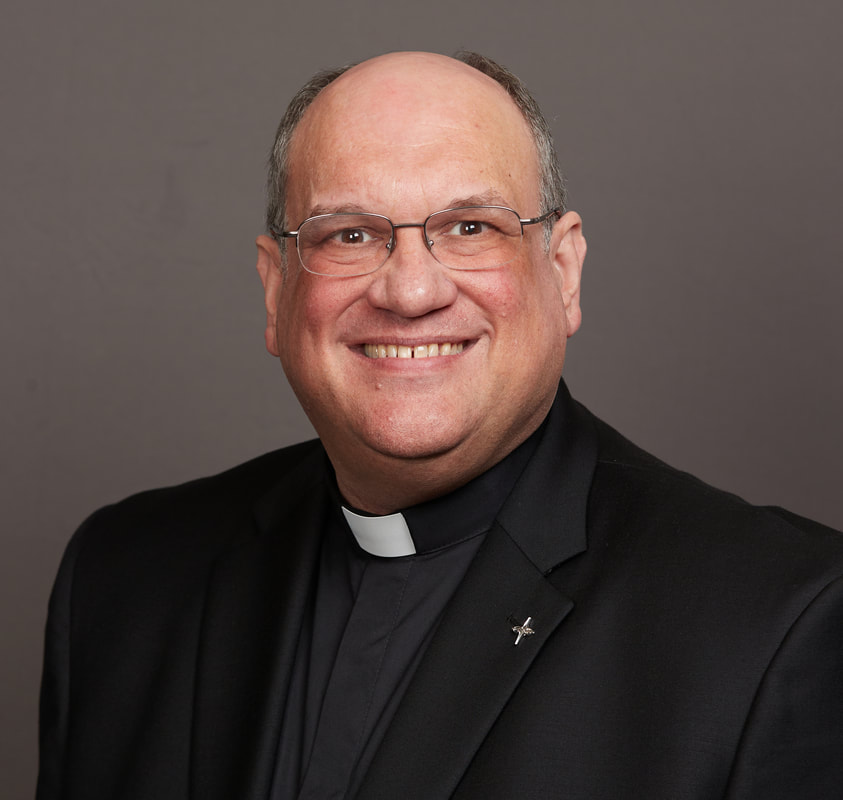
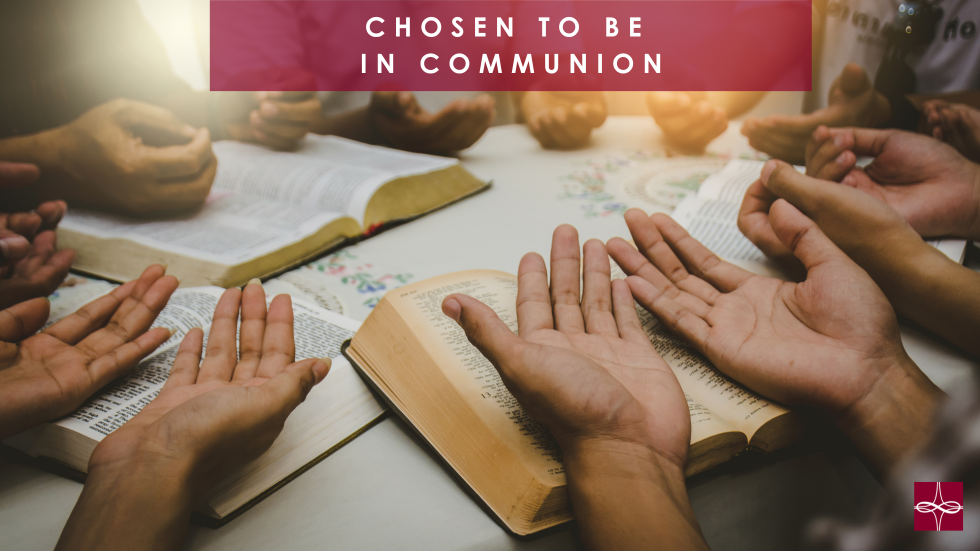
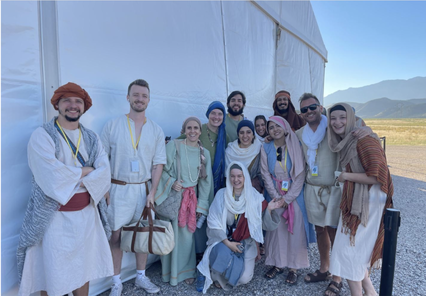
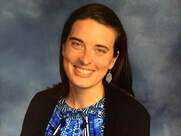
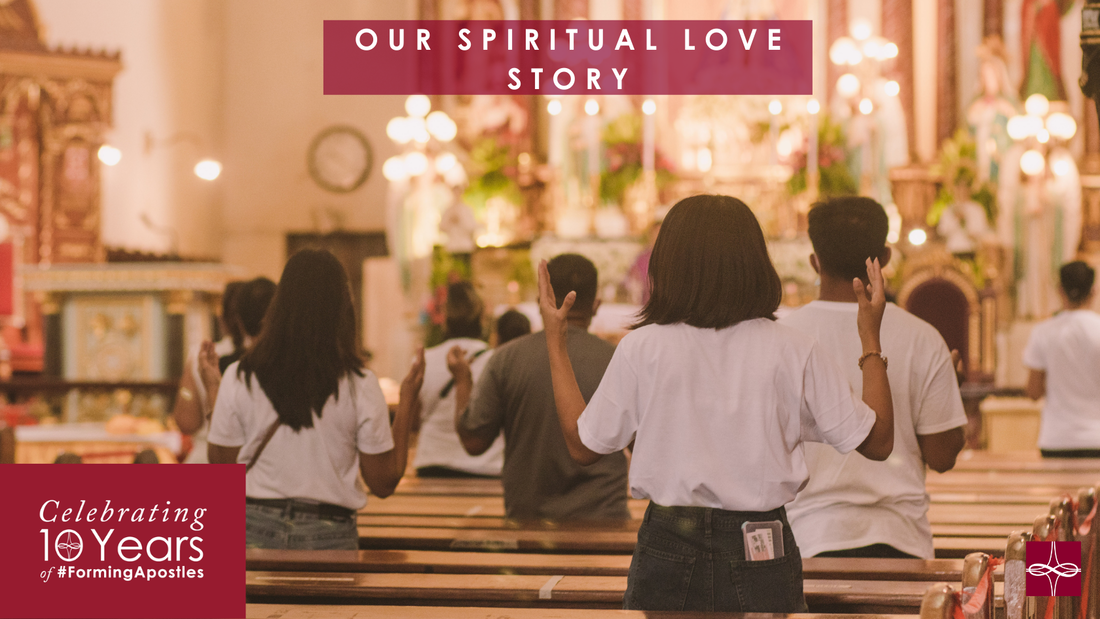

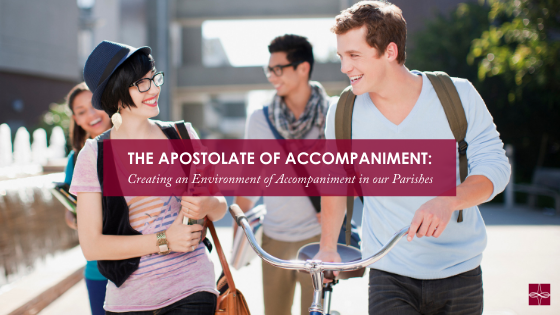

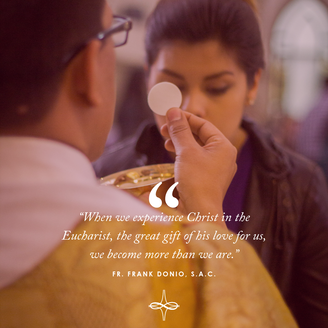
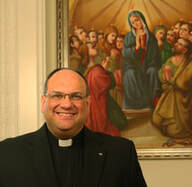
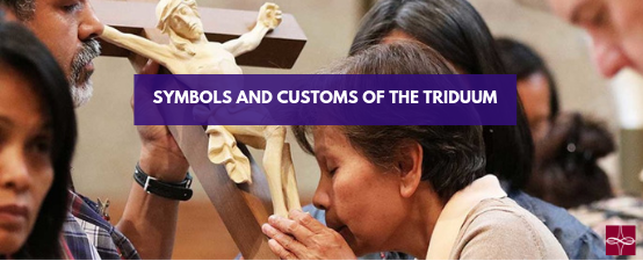



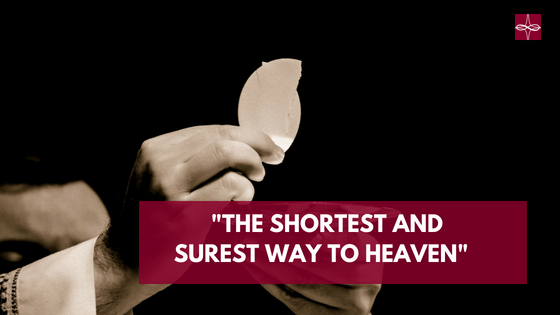


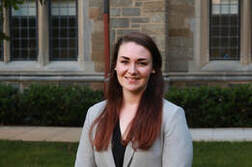
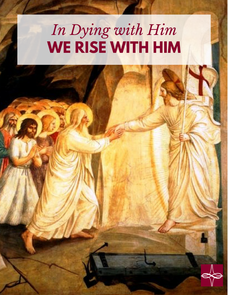




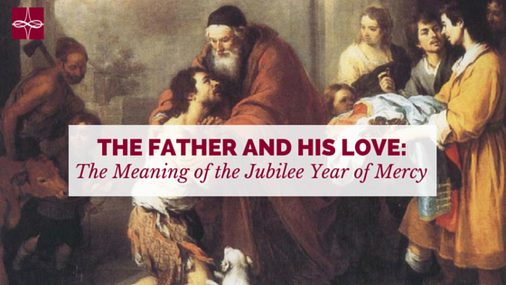



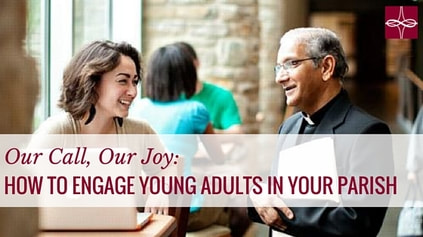

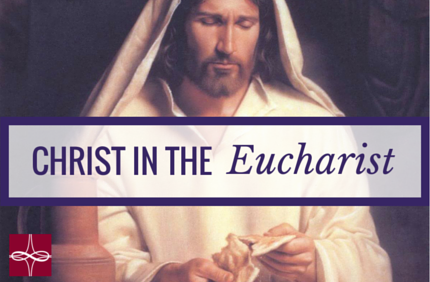

 RSS Feed
RSS Feed